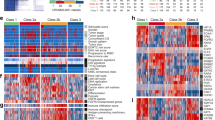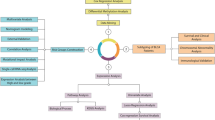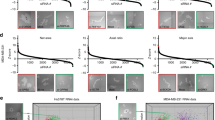Abstract
Cell migration is essential to cancer invasion and metastasis and is spatially and temporally integrated through transcriptionally dependent and independent mechanisms. As cell migration is studied in vitro, it is important to identify genes that both drive cell migration and are biologically relevant in promoting invasion and metastasis in patients with cancer. Here, gene expression profiling and a high-throughput cell migration system answers this question in human bladder cancer. In vitro migration rates of 40 microarray-profiled human bladder cancer cell lines were measured by radial migration assay. Genes whose expression was either directly or inversely associated with cell migration rate were identified and subsequently evaluated for their association with cancer stage in 61 patients. This analysis identified genes known to be associated with cell invasion such as versican, and novel ones, including metallothionein 1E (MT1E) and nicotinamide N-methyltransferase (NNMT), whose expression correlated positively with cancer cell migration and tumor stage. Using loss of function analysis, we show that MT1E and NNMT are necessary for cancer cell migration. These studies provide a general approach to identify the clinically relevant genes in cancer cell migration and mechanistically implicate two novel genes in this process in human bladder cancer.
This is a preview of subscription content, access via your institution
Access options
Subscribe to this journal
Receive 50 print issues and online access
$259.00 per year
only $5.18 per issue
Buy this article
- Purchase on Springer Link
- Instant access to full article PDF
Prices may be subject to local taxes which are calculated during checkout





Similar content being viewed by others
References
Aigner S, Sthoeger ZM, Fogel M, Weber E, Zarn J, Ruppert M et al. (1997). CD24, a mucin-type glycoprotein, is a ligand for P-selectin on human tumor cells. Blood 89: 3385–3395.
Aksoy S, Brandriff BF, Ward A, Little PF, Weinshilboum RM . (1995). Human nicotinamide N-methyltransferase gene: molecular cloning, structural characterization and chromosomal localization. Genomics 29: 555–561.
Aksoy S, Szumlanski CL, Weinshilboum RM . (1994). Human liver nicotinamide N-methyltransferase. cDNA cloning, expression, and biochemical characterization. J Biol Chem 269: 14835–14840.
Altevogt P, Lang E, Heckl-Ostreicher B, Benke R, Kratzin H, Schirrmacher V . (1988). Changes in metastasis formation and distinct cell surface molecules in adhesion variants of a metastatic murine tumor. Adv Exp Med Biol 233: 253–258.
Berens ME, Beaudry C . (2004). Radial monolayer cell migration assay. Methods Mol Med 88: 219–224.
Blaveri E, Simko JP, Korkola JE, Brewer JL, Baehner F, Mehta K et al. (2005). Bladder cancer outcome and subtype classification by gene expression. Clin Cancer Res 11: 4044–4055.
Calvano SE, Xiao W, Richards DR, Felciano RM, Baker HV, Cho RJ et al. (2005). A network-based analysis of systemic inflammation in humans. Nature 437: 1032–1037.
Chung MJ, Kang AY, Lee KM, Oh E, Jun HJ, Kim SY et al. (2006). Water-soluble genistin glycoside isoflavones up-regulate antioxidant metallothionein expression and scavenge free radicals. J Agric Food Chem 54: 3819–3826.
Clark EA, Golub TR, Lander ES, Hynes RO . (2000). Genomic analysis of metastasis reveals an essential role for RhoC. Nature 406: 532–535.
de Rooij J, Kerstens A, Danuser G, Schwartz MA, Waterman-Storer CM . (2005). Integrin-dependent actomyosin contraction regulates epithelial cell scattering. J Cell Biol 171: 153–164.
Dyrskjot L, Thykjaer T, Kruhoffer M, Jensen JL, Marcussen N, Hamilton-Dutoit S et al. (2003). Identifying distinct classes of bladder carcinoma using microarrays. Nat Genet 33: 90–96.
Faried A, Faried LS, Kimura H, Nakajima M, Sohda M, Miyazaki T et al. (2006). RhoA and RhoC proteins promote both cell proliferation and cell invasion of human oesophageal squamous cell carcinoma cell lines in vitro and in vivo. Eur J Cancer 42: 1455–1465.
Friederichs J, Zeller Y, Hafezi-Moghadam A, Grone HJ, Ley K, Altevogt P . (2000). The CD24/P-selectin binding pathway initiates lung arrest of human A125 adenocarcinoma cells. Cancer Res 60: 6714–6722.
Friedline JA, Garrett SH, Somji S, Todd JH, Sens DA . (1998). Differential expression of the MT-1E gene in estrogen-receptor-positive and -negative human breast cancer cell lines. Am J Pathol 152: 23–27.
Gildea JJ, Seraj MJ, Oxford G, Harding MA, Hampton GM, Moskaluk CA et al. (2002). RhoGDI2 is an invasion and metastasis suppressor gene in human cancer. Cancer Res 62: 6418–6423.
Gordon JN, Shu WP, Schlussel RN, Droller MJ, Liu BC . (1993). Altered extracellular matrices influence cellular processes and nuclear matrix organizations of overlying human bladder urothelial cells. Cancer Res 53: 4971–4977.
Grate LR . (2005). Many accurate small-discriminatory feature subsets exist in microarray transcript data: biomarker discovery. BMC Bioinformatics 6: 97.
Havaleshko DM, Cho H, Conaway M, Owens CR, Hampton G, Lee JK et al. (2007). Prediction of drug combination chemosensitivity in human bladder cancer. Mol Cancer Ther 6: 578–586.
Jemal A, Murray T, Ward E, Samuels A, Tiwari RC, Ghafoor A et al. (2005). Cancer statistics, 2005. CA Cancer J Clin 55: 10–30.
Jin R, Bay BH, Chow VT, Tan PH, Lin VC . (2000). Metallothionein 1E mRNA is highly expressed in oestrogen receptor-negative human invasive ductal breast cancer. Br J Cancer 83: 319–323.
Jones RF, Debiec-Rychter M, Wang CY . (1992). Chemical carcinogenesis of the urinary bladder–a status report. J Cancer Res Clin Oncol 118: 411–419.
Kodama J, Hasengaowa, Kusumoto T, Seki N, Matsuo T, Ojima Y et al. (2007). Prognostic significance of stromal versican expression in human endometrial cancer. Ann Oncol 18: 269–274.
Kristiansen G, Sammar M, Altevogt P . (2004). Tumour biological aspects of CD24, a mucin-like adhesion molecule. J Mol Histol 35: 255–262.
Lee JK, Havaleshko DM, Cho H, Weinstein JN, Kaldjian EP, Karpovich J et al. (2007). A strategy for predicting the chemosensitivity of human cancers and its application to drug discovery. Proc Natl Acad Sci USA 104: 13086–13091.
Li CJ, Li RW, Wang YH, Elsasser TH . (2007). Pathway analysis identifies perturbation of genetic networks induced by butyrate in a bovine kidney epithelial cell line. Funct Integr Genomics 7: 193–205.
Lim BH, Cho BI, Kim YN, Kim JW, Park ST, Lee CW . (2006). Overexpression of nicotinamide N-methyltransferase in gastric cancer tissues and its potential post-translational modification. Exp Mol Med 38: 455–465.
Liotta L, Petricoin E . (2000). Molecular profiling of human cancer. Nat Rev Genet 1: 48–56.
Margolis EJ, Choi JC, Shu WP, Liu BC . (1996). Specific sequences of fibronectin activate the protein kinase C signal transduction pathway in invasive bladder cancer. Cancer Lett 100: 163–168.
Mayburd AL, Martlinez A, Sackett D, Liu H, Shih J, Tauler J et al. (2006). Ingenuity network-assisted transcription profiling: Identification of a new pharmacologic mechanism for MK886. Clin Cancer Res 12: 1820–1827.
Modlich O, Prisack HB, Pitschke G, Ramp U, Ackermann R, Bojar H et al. (2004). Identifying superficial, muscle-invasive, and metastasizing transitional cell carcinoma of the bladder: use of cDNA array analysis of gene expression profiles. Clin Cancer Res 10: 3410–3421.
Mukai M, Endo H, Iwasaki T, Tatsuta M, Togawa A, Nakamura H et al. (2006). RhoC is essential for TGF-beta1-induced invasive capacity of rat ascites hepatoma cells. Biochem Biophys Res Commun 346: 74–82.
Nicholson BE, Frierson HF, Conaway MR, Seraj JM, Harding MA, Hampton GM et al. (2004). Profiling the evolution of human metastatic bladder cancer. Cancer Res 64: 7813–7821.
Oxford G, Owens CR, Titus BJ, Foreman TL, Herlevsen MC, Smith SC et al. (2005). RalA and RalB: antagonistic relatives in cancer cell migration. Cancer Res 65: 7111–7120.
Pukkila M, Kosunen A, Ropponen K, Virtaniemi J, Kellokoski J, Kumpulainen E et al. (2007). High stromal versican expression predicts unfavourable outcome in oral squamous cell carcinoma. J Clin Pathol 60: 267–272.
Ramaswamy S, Ross KN, Lander ES, Golub TR . (2003). A molecular signature of metastasis in primary solid tumors. Nat Genet 33: 49–54.
Ricciardelli C, Quinn DI, Raymond WA, McCaul K, Sutherland PD, Stricker PD et al. (1999). Elevated levels of peritumoral chondroitin sulfate are predictive of poor prognosis in patients treated by radical prostatectomy for early-stage prostate cancer. Cancer Res 59: 2324–2328.
Roessler M, Rollinger W, Palme S, Hagmann ML, Berndt P, Engel AM et al. (2005). Identification of nicotinamide N-methyltransferase as a novel serum tumor marker for colorectal cancer. Clin Cancer Res 11: 6550–6557.
Sanchez-Carbayo M, Socci ND, Lozano J, Saint F, Cordon-Cardo C . (2006). Defining molecular profiles of poor outcome in patients with invasive bladder cancer using oligonucleotide microarrays. J Clin Oncol 24: 778–789.
Sanchez-Carbayo M, Socci ND, Lozano JJ, Li W, Charytonowicz E, Belbin TJ et al. (2003). Gene discovery in bladder cancer progression using cDNA microarrays. Am J Pathol 163: 505–516.
Smith SC, Oxford G, Baras AS, Owens C, Havaleshko D, Brautigan DL et al. (2007). Expression of ral GTPases, their effectors, and activators in human bladder cancer. Clin Cancer Res 13: 3803–3813.
Smith SC, Oxford G, Wu Z, Nitz MD, Conaway M, Frierson HF et al. (2006). The metastasis-associated gene CD24 is regulated by Ral GTPase and is a mediator of cell proliferation and survival in human cancer. Cancer Res 66: 1917–1922.
Stein JP, Lieskovsky G, Cote R, Groshen S, Feng AC, Boyd S et al. (2001). Radical cystectomy in the treatment of invasive bladder cancer: long-term results in 1054 patients. J Clin Oncol 19: 666–675.
Su AI, Welsh JB, Sapinoso LM, Kern SG, Dimitrov P, Lapp H et al. (2001). Molecular classification of human carcinomas by use of gene expression signatures. Cancer Res 61: 7388–7393.
Team RDC . (2003). R Reference Manual. Network Theory: Vienna, 736 pp.
Theodorescu D, Sapinoso LM, Conaway MR, Oxford G, Hampton GM, Frierson Jr HF . (2004). Reduced expression of metastasis suppressor RhoGDI2 is associated with decreased survival for patients with bladder cancer. Clin Cancer Res 10: 3800–3806.
Thykjaer T, Workman C, Kruhoffer M, Demtroder K, Wolf H, Andersen LD et al. (2001). Identification of gene expression patterns in superficial and invasive human bladder cancer. Cancer Res 61: 2492–2499.
Titus B, Frierson Jr HF, Conaway M, Ching K, Guise T, Chirgwin J et al. (2005). Endothelin axis is a target of the lung metastasis suppressor gene RhoGDI2. Cancer Res 65: 7320–7327.
van Delft JH, van Agen E, van Breda SG, Herwijnen MH, Staal YC, Kleinjans JC . (2005). Comparison of supervised clustering methods to discriminate genotoxic from non-genotoxic carcinogens by gene expression profiling. Mutat Res 575: 17–33.
Witjes JA . (2006). Management of BCG failures in superficial bladder cancer: a review. Eur Urol 49: 790–797.
Xu J, Moatamed F, Caldwell JS, Walker JR, Kraiem Z, Taki K et al. (2003). Enhanced expression of nicotinamide N-methyltransferase in human papillary thyroid carcinoma cells. J Clin Endocrinol Metab 88: 4990–4996.
Yao M, Tabuchi H, Nagashima Y, Baba M, Nakaigawa N, Ishiguro H et al. (2005). Gene expression analysis of renal carcinoma: adipose differentiation-related protein as a potential diagnostic and prognostic biomarker for clear-cell renal carcinoma. J Pathol 205: 377–387.
Zheng PS, Wen J, Ang LC, Sheng W, Viloria-Petit A, Wang Y et al. (2004). Versican/PG-M G3 domain promotes tumor growth and angiogenesis. FASEB J 18: 754–756.
Acknowledgements
We thank Dr Jay Fox and Dr Yongde Bao of the University of Virginia Array Core facility for their assistance with chip hybridization. We also thank Dr Martin A Schwartz and Dr Konstadinos Moissoglu of the Cardiovascular Research Center, University of Virginia for their assistance with time-lapse microscopy. Mr Christian Beaudry at TGen performed the high-throughput cell migration experiments. This work was supported by NIH grant CA075115 to DT.
Author information
Authors and Affiliations
Corresponding author
Additional information
Conflict of interest
The authors declare that they have no competing financial interests.
Supplementary Information accompanies the paper on the Oncogene website (http://www.nature.com/onc)
Supplementary information
Rights and permissions
About this article
Cite this article
Wu, Y., Siadaty, M., Berens, M. et al. Overlapping gene expression profiles of cell migration and tumor invasion in human bladder cancer identify metallothionein 1E and nicotinamide N-methyltransferase as novel regulators of cell migration. Oncogene 27, 6679–6689 (2008). https://doi.org/10.1038/onc.2008.264
Received:
Revised:
Accepted:
Published:
Issue Date:
DOI: https://doi.org/10.1038/onc.2008.264
Keywords
This article is cited by
-
Knockdown of nicotinamide N-methyltransferase suppresses proliferation, migration, and chemoresistance of Merkel cell carcinoma cells in vitro
Human Cell (2024)
-
TRIM56 acts through the IQGAP1-CDC42 signaling axis to promote glioma cell migration and invasion
Cell Death & Disease (2023)
-
Complex roles of nicotinamide N-methyltransferase in cancer progression
Cell Death & Disease (2022)
-
A proteogenomic analysis of clear cell renal cell carcinoma in a Chinese population
Nature Communications (2022)
-
Patients with low nicotinamide N-methyltransferase expression benefit significantly from bevacizumab treatment in ovarian cancer
BMC Cancer (2021)



